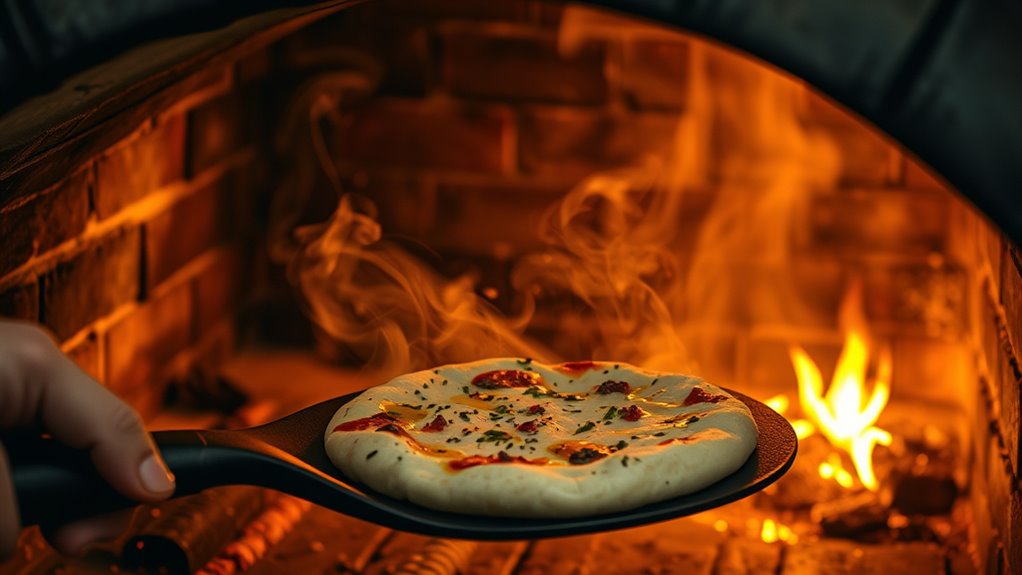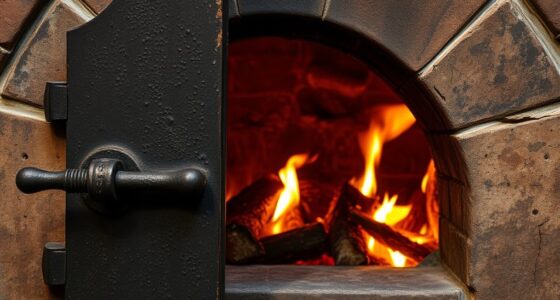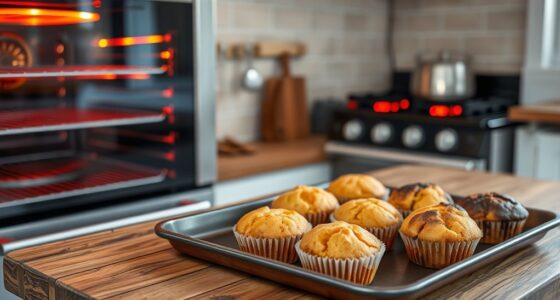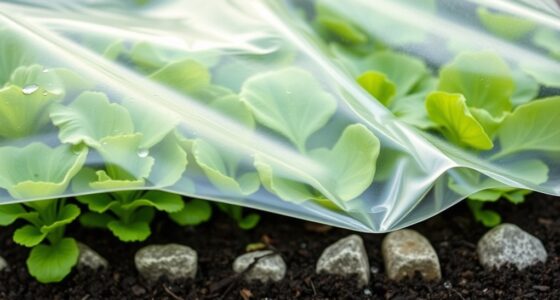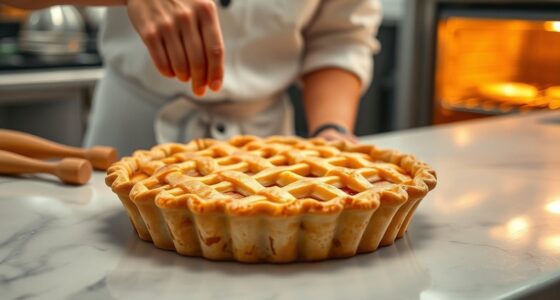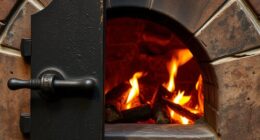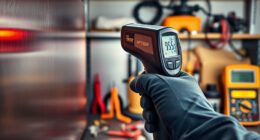To season your new pizza oven through blind firing, start by heating it gradually to burn off manufacturing residues and create a durable surface. Keep a fire extinguisher nearby, guarantee good ventilation, and never leave it unattended during the process. Monitor closely for sparks or smoke, and let the oven cool naturally afterward to prevent rust and guarantee long-term performance. Continue with detailed steps to help you get the most out of your oven’s first burn.
Key Takeaways
- Remove residues and excess materials through blind firing to create a durable, protective coating.
- Gradually heat the oven over a couple of hours, ensuring even curing and preventing damage.
- Keep a fire extinguisher nearby and ensure proper ventilation during initial firing for safety.
- Monitor the process closely, pausing if sparks or smoke indicate issues, and inspect parts before and after firing.
- Allow the oven to cool naturally after firing to evaporate moisture and prolong its lifespan.

When you first fire up your new pizza oven, it’s imperative to go through a process called blind firing to season it properly. This step helps remove any residues from manufacturing, burn off excess materials, and create a protective coating that guarantees your oven performs well over time. During this initial burn, focus on maintaining proper fire safety by keeping a fire extinguisher nearby and ensuring your space is well-ventilated. Never leave the oven unattended while it’s heating up, and watch for any signs of smoke or unusual odors, which could indicate issues needing immediate attention. Proper fire safety isn’t just about preventing accidents—it also safeguards your investment and sets the foundation for safe oven operation in the future.
As the oven heats up gradually, you’ll notice a change in how the interior materials burn and settle. This is normal, but it’s important to monitor the process closely. If you see any sparks or excessive smoke, pause the process, turn off the heat, and inspect for potential problems. Regular oven maintenance begins right here, with checking for any loose or damaged parts before and after the firing process. Keeping the oven clean of dust, debris, or any packaging materials before you start is also essential. A well-maintained oven not only improves safety but also enhances performance, ensuring heat distributes evenly and your pizzas cook perfectly.
During this blind firing, avoid rushing the process. Gradually increase the temperature over a couple of hours, allowing the materials to cure slowly. This helps prevent cracking or warping and creates a durable, seasoned surface that improves the flavor and texture of your pizzas. Once the initial burn is complete, turn the heat off and let the oven cool down naturally. This cool-down period is critical for oven maintenance because it allows any residual moisture to evaporate, reducing the risk of rust and prolonging the lifespan of your oven. Additionally, understanding the importance of natural materials such as wood, stone, and linen can help you better appreciate the benefits of proper seasoning and maintenance for your pizza oven.
Frequently Asked Questions
How Often Should I Blind Fire My Pizza Oven?
You should blind fire your pizza oven about once a week during the initial seasoning process. Keep the oven temperature around 500°F, and use a small to medium fire size for safety and even seasoning. This routine helps build a durable, non-stick surface and guarantees proper heat distribution. After the first month, you can reduce the frequency to monthly or as needed, depending on how often you use your oven.
Can I Use My Oven Immediately After Seasoning?
Yes, you can use your oven immediately after seasoning, but make sure you’ve completed the seasoning techniques properly first. It’s a good idea to wait until the initial smoke clears and the oven cools down slightly. This helps with oven cleaning and guarantees the seasoning layer is set. Rushing into use might affect performance, so give it a little time to settle for the best pizza results.
What Type of Wood Is Best for Blind Firing?
Did you know that oak burns longer and produces less creosote than other woods? For blind firing, choose hardwoods like oak, hickory, or maple for critical performance. Proper wood selection is essential; avoid softwoods that burn quickly and produce more smoke. Make certain of proper seasoning duration—at least 6-12 months—to enhance flavor and safety. Using well-seasoned hardwoods guarantees a cleaner burn and better oven seasoning results.
How Do I Know When My Oven Is Properly Seasoned?
You’ll know your oven is properly seasoned when the interior reaches a stable temperature, usually around 500°F, and maintains it consistently during the seasoning duration. Look for a shiny, slightly smoky residue and a dry, seasoned smell. After several hours of seasoning, the oven should have a uniform color and no strong odors. Keep monitoring the oven temperature to make certain it stays steady throughout the seasoning process.
Are There Safety Concerns During the Blind Firing Process?
Yes, there are safety concerns during blind firing. You should prioritize fire safety by staying nearby and keeping a fire extinguisher handy. Make certain proper ventilation precautions are in place to avoid smoke buildup and harmful fumes. Never leave the oven unattended, and follow manufacturer instructions carefully. This way, you minimize risks and safely season your pizza oven for peak performance.
Conclusion
Think of seasoning your new pizza oven like planting a garden; with patience and care, it blooms into something extraordinary. By blind firing your oven, you’re laying a solid foundation for perfect pizzas and long-lasting performance. Don’t rush this process—each burn builds trust in your oven’s potential. Before long, your oven will be a well-tuned instrument, ready to craft delicious memories. Embrace the journey, and watch your pizza dreams rise as beautifully as a sunrise.
